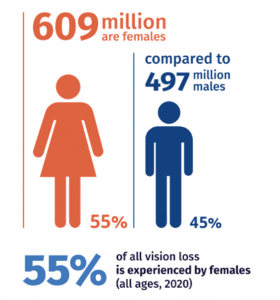Join a powerful, unprecedented alliance for better eye health for all.
Join IAPB-
Choose an alternate language here
Unless women and girls are given the opportunity to their rightful education, and their rightful healthcare, their capacity to participate in public life, in electoral processes, and ultimately, to lead politically to build peace, to be involved in peace processes is all affected by them being prevented from full participation in education. – H.E Ambassador Geraldine Byrne Nason, Ireland, UN Friends of Vision
Good vision and eye health unlocks people’s potential to get an education, earn a living and maintain well-being.
Of the 1.1 billion people that are living with vision loss, 55% are women and girls.(1)

Recording and analysing disaggregated data allows us to understand what disparities exist, explore why and look for solutions to ensure the eye care needs of women are being met.
Although women have a longer life expectancy than men, this does not fully explain the higher rates of vision loss. The persistent gender difference suggests that, in many settings, the greater vision loss experienced by women is socially determined. (2)
Being able to access good quality eye care is the key to reducing disparities. Relatively inexpensive interventions can prevent vision loss, but women are less likely to access them.(3)
Data and evidence from research, case studies, and evaluations can provide opportunities to identify where interventions can be successfully driven by data to target inequalities. For instance:
With so far to go to achieve gender equity at a broader sense, good quality eye health must be provided to women and girls at levels that is proportional to need. This must happen so that vision loss does not affect girl’s ability to get an education, earn a living, maintain well-being and ultimately have the capacity to participate in public life. To lead and be leaders and achieve and equal future.